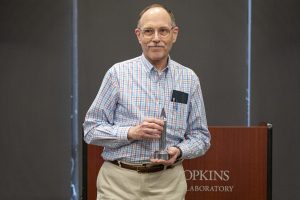
The following was originally published on the Johns Hopkins Applied Physics Laboratory’s website.
When Wayne Sternberger received the inaugural “Archimedes Award” through the Johns Hopkins Applied Physics Laboratory’s Entrepreneurial & Staff Alumni Program (AeSAP) in February, he was ready to run with the award offerings — two years of office and lab space in Johns Hopkins Technology Ventures’ (JHTV) FastForward innovation hubs, access to JHTV’s resources and APL benefits — to commercialize his neural blockade monitor.
Then a global pandemic hit.
But while some things ground to a halt, Sternberger, a systems engineer at APL, pressed on. He had anticipated spending a few months tying up his work at APL before forging ahead with the business opportunity afforded by AeSAP and the Archimedes Award. He quickly scaled back ideas to build up his company in person and incorporated going almost entirely virtual into his evolving business plan.
That work paid off as Sternberger signed a licensing agreement with APL’s Tech Transfer Office for his newly formed company, BLOCKsynop, to begin commercializing the neural blockade monitor that he’s spent the last 20 years perfecting with co-inventor and business partner Dr. Robert Greenberg, a pediatric anesthesiologist at Johns Hopkins Medicine (JHM).
“We have been fairly successful working in a virtual environment, and in some cases it has actually helped,” said Sternberger. “We were able to interview clinicians from across the U.S. for our user needs research without incorporating travel time and cost. We also recruited a medical device marketing specialist as well as college interns from outside the area who have integrated with the team seamlessly.”
During his time at APL, Sternberger specialized in sensor design, instrumentation development and system integration. His interests diverged into the biomedical field when he took part in the Sabbatical Fellows and Professors Program in the mid-1990s, with a fellowship at JHM focused on bringing systems engineering capabilities and knowledge to anesthesiology and critical care medicine.
As he worked directly with clinical staff members and the medical community, he realized there was a need to quantitatively and objectively determine how well a neural blockade — local anesthetic — was working, especially for patients who may not have the ability to express themselves (infants, for example). Even today, the standard of care is still the same for adults and children, regardless of factors such as weight and height.
“This links back to what I do as a systems engineer,” Sternberger said when he received his Archimedes Award earlier this year. “Everyone has an opinion in the medical community on how to solve problems; systems engineering comes in to assess that problem and take potential options and hone it down to an appropriate solution that exists.”
AeSAP, introduced to APL staff members in December 2019, enables employees to leave the Lab to launch or join a startup company, and return to APL within two years. Applicants can compete for the “Archimedes Award” to receive additional resources that will help them transition concepts into commercially viable products.
“As APL’s first Archimedes recipient, we celebrate each milestone and award along with Wayne and the BLOCKsynop team,” said Norma Lee Todd of APL’s Tech Transfer office. “We look forward to following along with their continued success.”
Part of the Archimedes package included the I-Corps program, which Sternberger and his BLOCKsynop team completed entirely through Zoom this past May. The I-Corps program, developed by the National Science Foundation, prepares scientists and engineers to accelerate research projects that are ready to move toward commercialization.
The company also earned a grant from the Maryland Technology Development Corporation, known as TEDCO.
BLOCKsynop will now take the existing engineering prototype of the neural blockade monitor and create an optimized version for clinical trials. The clinical prototype will then be tested at three universities on the East Coast, including Johns Hopkins University, in an effort to secure Food and Drug Administration approval.
After spending two decades working on his neural blockade monitor and receiving two patents, Sternberger now hopes that commercializing his idea will help elevate the safety and quality of patient care, and reduce medical costs.
“With this licensing agreement, we’re looking forward to bringing the BLOCKsynop neural blockade monitor to market,” he said, “and giving the medical community a new and unparalleled tool to provide patients with pain-free surgery and recovery using the lowest possible level of analgesics.